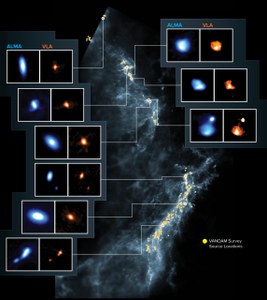A Census of the Orion Protostars
 Tobin et al. conducted a survey of 328 protostars in the Orion molecular clouds with ALMA at 0.87 mm at a resolution of ~0.14 milli-arcseconds (40 AU), including observations with the Jansky VLA at 9 mm toward 148 protostars at a resolution of ~0.08 milli-arcseconds (32 AU). This is the largest multiwavelength survey of protostars at this resolution by an order of magnitude. The authors use the dust continuum emission at 0.87 and 9 mm to measure the dust disk radii and masses toward the Class 0, Class I, and flat-spectrum protostars, characterizing the evolution of these disk properties in the protostellar phase. The mean dust disk radii for the Class 0, Class I, and flat-spectrum protostars are 44+5.8−3.4, 37+4.9−3.0 and 28.5+3.7−2.3 AU, respectively, and the mean protostellar dust disk masses 25.9+7.7−4.0 , 14.9+3.8−2.2, and 11.6+3.5−1.9 M⊕, respectively. The decrease in dust disk masses is expected from disk evolution and accretion, but the decrease in disk radii may point to the initial conditions of star formation not leading to the systematic growth of disk radii or that radial drift is keeping the dust disk sizes small. At least 146 of these protostellar disks – 35% of 379 detected 0.87 mm continuum sources plus 42 nondetections – have disk radii greater than 50 AU. These properties are not found to vary significantly between different regions within Orion. The protostellar dust disk mass distributions are systematically larger than those of Class II disks by a factor of more than four, providing evidence that the cores of giant planets may need to at least begin their formation during the protostellar phase.
Tobin et al. conducted a survey of 328 protostars in the Orion molecular clouds with ALMA at 0.87 mm at a resolution of ~0.14 milli-arcseconds (40 AU), including observations with the Jansky VLA at 9 mm toward 148 protostars at a resolution of ~0.08 milli-arcseconds (32 AU). This is the largest multiwavelength survey of protostars at this resolution by an order of magnitude. The authors use the dust continuum emission at 0.87 and 9 mm to measure the dust disk radii and masses toward the Class 0, Class I, and flat-spectrum protostars, characterizing the evolution of these disk properties in the protostellar phase. The mean dust disk radii for the Class 0, Class I, and flat-spectrum protostars are 44+5.8−3.4, 37+4.9−3.0 and 28.5+3.7−2.3 AU, respectively, and the mean protostellar dust disk masses 25.9+7.7−4.0 , 14.9+3.8−2.2, and 11.6+3.5−1.9 M⊕, respectively. The decrease in dust disk masses is expected from disk evolution and accretion, but the decrease in disk radii may point to the initial conditions of star formation not leading to the systematic growth of disk radii or that radial drift is keeping the dust disk sizes small. At least 146 of these protostellar disks – 35% of 379 detected 0.87 mm continuum sources plus 42 nondetections – have disk radii greater than 50 AU. These properties are not found to vary significantly between different regions within Orion. The protostellar dust disk mass distributions are systematically larger than those of Class II disks by a factor of more than four, providing evidence that the cores of giant planets may need to at least begin their formation during the protostellar phase.
Figure caption: Herschel infrared image of the Orion Molecular Cloud [Insets] VLA 32 GHz and ALMA 250 GHz, sample images of protostars in the VANDAM sample.
Publication: John J. Tobin (National Radio Astronomy Observatory) et al., The VLA/ALMA Nascent Disk and Multiplicity (VANDAM) Survey of Orion Protostars. II. A Statistical Characterization of Class 0 and Class I Protostellar Disks, Astrophysical Journal, 890, 130 (20 February 2020).
NRAO Press Release: How Newborn Stars Prepare for the Birth of Planets




Connect with NRAO